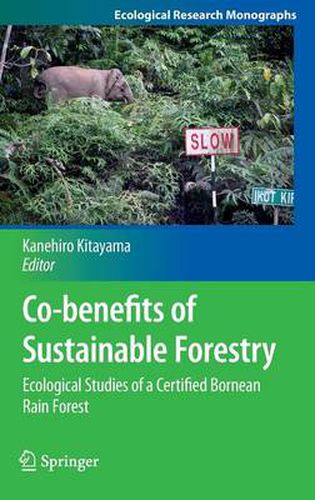Readings Newsletter
Become a Readings Member to make your shopping experience even easier.
Sign in or sign up for free!
You’re not far away from qualifying for FREE standard shipping within Australia
You’ve qualified for FREE standard shipping within Australia
The cart is loading…






This title is printed to order. This book may have been self-published. If so, we cannot guarantee the quality of the content. In the main most books will have gone through the editing process however some may not. We therefore suggest that you be aware of this before ordering this book. If in doubt check either the author or publisher’s details as we are unable to accept any returns unless they are faulty. Please contact us if you have any questions.
Tropical rain forests are increasingly expected to serve for climate change mitigation and biodiversity conservation amid global climate change and increasing human demands for land. Natural production forests that are legally designated to produce timber occur widely in the Southeast Asian tropics. Synergizing timber production, climate change mitigation and biodiversity conservation in such tropical production forests is one of the most realistic means to resolve these contemporary global problems. Next-generation sustainable forest management is being practiced in the natural tropical rain forest of a model site in Sabah, Malaysian Borneo, while earlier sustainable management practices have generally failed, leading to extensive deforestation and forest degradation elsewhere in the tropics. Ecologists have examined co-benefits of sustainable forestry in the model forest in terms of forest regeneration, carbon sequestration and biodiversity in comparison to a forest managed by destructive conventional methods. Taxonomic groups studied have included trees, decomposers, soil microbes, insects and mammals. A wide array of field methods and technology has been used including count plots, sensor cameras, and satellite remote-sensing. This book is a compilation of the results of those thorough ecological investigations and elucidates ecological processes of tropical rain forests after logging. The book furnishes useful information for foresters and conservation NGOs, and it also provides baseline information for biologists and ecologists. A further aim is to examine the environmental effects of a forest certification scheme as the model forest has been certified by the Forest Stewardship Council. Taken as a whole, this book proves that the desired synergy is possible.
$9.00 standard shipping within Australia
FREE standard shipping within Australia for orders over $100.00
Express & International shipping calculated at checkout
This title is printed to order. This book may have been self-published. If so, we cannot guarantee the quality of the content. In the main most books will have gone through the editing process however some may not. We therefore suggest that you be aware of this before ordering this book. If in doubt check either the author or publisher’s details as we are unable to accept any returns unless they are faulty. Please contact us if you have any questions.
Tropical rain forests are increasingly expected to serve for climate change mitigation and biodiversity conservation amid global climate change and increasing human demands for land. Natural production forests that are legally designated to produce timber occur widely in the Southeast Asian tropics. Synergizing timber production, climate change mitigation and biodiversity conservation in such tropical production forests is one of the most realistic means to resolve these contemporary global problems. Next-generation sustainable forest management is being practiced in the natural tropical rain forest of a model site in Sabah, Malaysian Borneo, while earlier sustainable management practices have generally failed, leading to extensive deforestation and forest degradation elsewhere in the tropics. Ecologists have examined co-benefits of sustainable forestry in the model forest in terms of forest regeneration, carbon sequestration and biodiversity in comparison to a forest managed by destructive conventional methods. Taxonomic groups studied have included trees, decomposers, soil microbes, insects and mammals. A wide array of field methods and technology has been used including count plots, sensor cameras, and satellite remote-sensing. This book is a compilation of the results of those thorough ecological investigations and elucidates ecological processes of tropical rain forests after logging. The book furnishes useful information for foresters and conservation NGOs, and it also provides baseline information for biologists and ecologists. A further aim is to examine the environmental effects of a forest certification scheme as the model forest has been certified by the Forest Stewardship Council. Taken as a whole, this book proves that the desired synergy is possible.